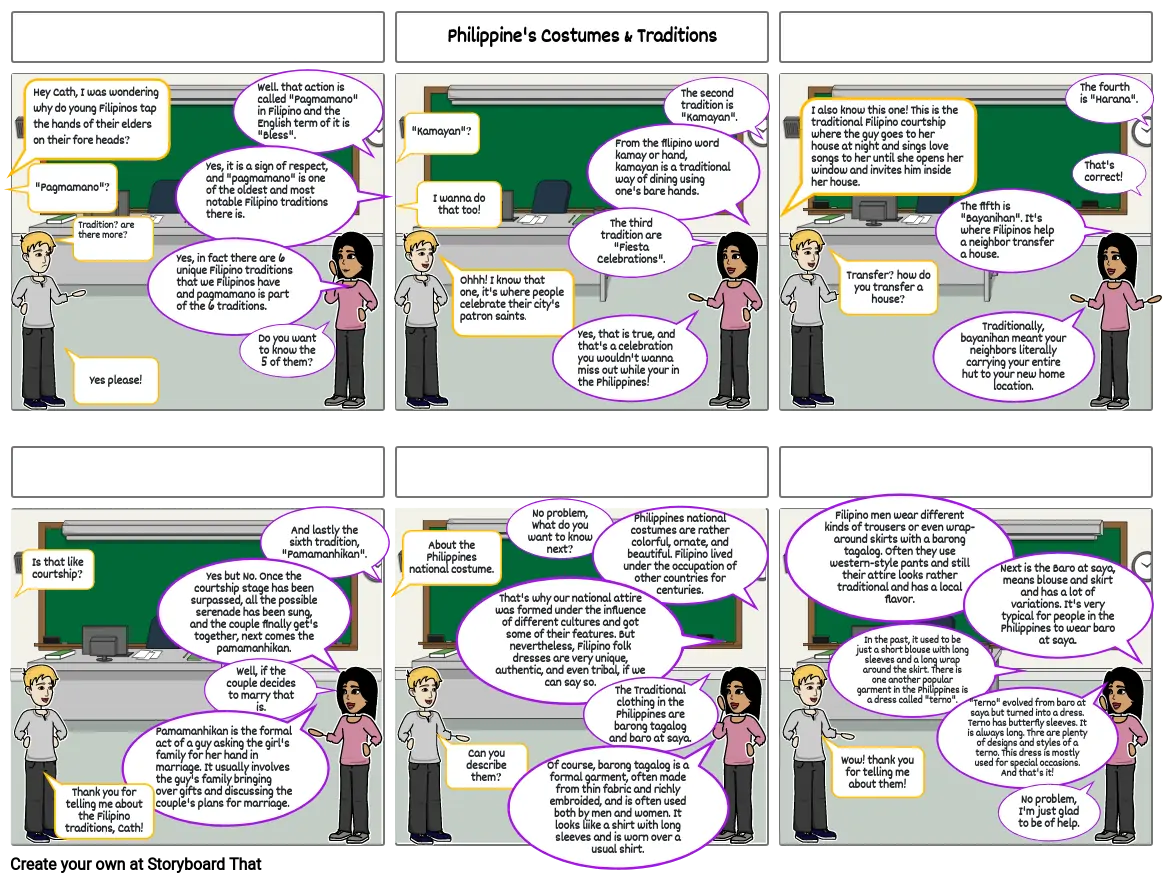Philippine's costumes and traditions

Storyboard Text
- "Pagmamano"?
- Hey Cath, I was wondering why do young Filipinos tap the hands of their elders on their fore heads?
- Tradition? are there more?
- Yes please!
- Well. that action is called "Pagmamano" in Filipino and the English term of it is "Bless".
- Do you want to know the 5 of them?
- Yes, in fact there are 6 unique Filipino traditions that we Filipinos have and pagmamano is part of the 6 traditions.
- Yes, it is a sign of respect, and "pagmamano" is one of the oldest and most notable Filipino traditions there is.
- I wanna do that too!
- "Kamayan"?
- Ohhh! I know that one, it's where people celebrate their city's patron saints.
- Yes, that is true, and that's a celebration you wouldn't wanna miss out while your in the Philippines!
- From the filipino word kamay or hand, kamayan is a traditional way of dining using one's bare hands.
- The second tradition is "Kamayan".
- The third tradition are "Fiesta Celebrations".
- I also know this one! This is the traditional Filipino courtship where the guy goes to her house at night and sings love songs to her until she opens her window and invites him inside her house.
- Filipino men wear different kinds of trousers or even wrap-around skirts with a barong tagalog. Often they use western-style pants and still their attire looks rather traditional and has a local flavor.
- Transfer? how do you transfer a house?
- Traditionally, bayanihan meant your neighbors literally carrying your entire hut to your new home location.
- The fourth is "Harana".
- That's correct!
- The fifth is "Bayanihan". It's where Filipinos help a neighbor transfer a house.
- Is that like courtship?
- Thank you for telling me about the Filipino traditions, Cath!
- Pamamanhikan is the formal act of a guy asking the girl's family for her hand in marriage. It usually involves the guy's family bringing over gifts and discussing the couple's plans for marriage.
- Yes but No. Once the courtship stage has been surpassed, all the possible serenade has been sung, and the couple finally get's together, next comes the pamamanhikan.
- And lastly the sixth tradition, "Pamamanhikan".
- Well, if the couple decides to marry that is.
- About the Philippines national costume.
- Can you describe them?
- No problem, What do you want to know next?
- Of course, barong tagalog is a formal garment, often made from thin fabric and richly embroided, and is often used both by men and women. It looks liike a shirt with long sleeves and is worn over a usual shirt.
- The Traditional clothing in the Philippines are barong tagalog and baro at saya.
- Philippines national costumes are rather colorful, ornate, and beautiful. Filipino lived under the occupation of other countries for centuries.
- That's why our national attire was formed under the influence of different cultures and got some of their features. But nevertheless, Filipino folk dresses are very unique, authentic, and even tribal, if we can say so.
- Wow! thank you for telling me about them!
- "Terno" evolved from baro at saya but turned into a dress. Terno has butterfly sleeves. It is always long. Thre are plenty of designs and styles of a terno. This dress is mostly used for special occasions. And that's it!
- Next is the Baro at saya, means blouse and skirt and has a lot of variations. It's very typical for people in the Philippines to wear baro at saya.
- No problem, I'm just glad to be of help.
- In the past, it used to be just a short blouse with long sleeves and a long wrap around the skirt. There is one another popular garment in the Philippines is a dress called "terno".
Over 30 Million Storyboards Created

